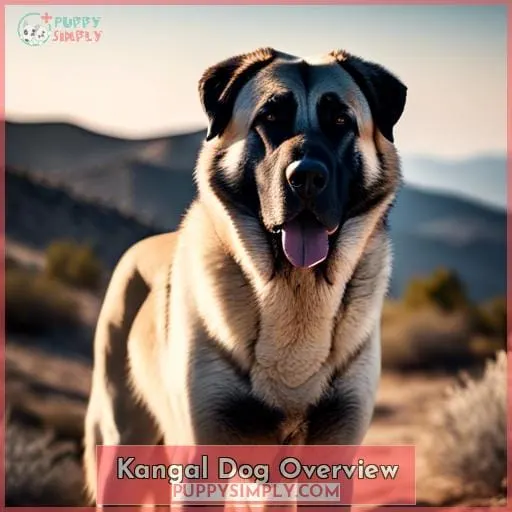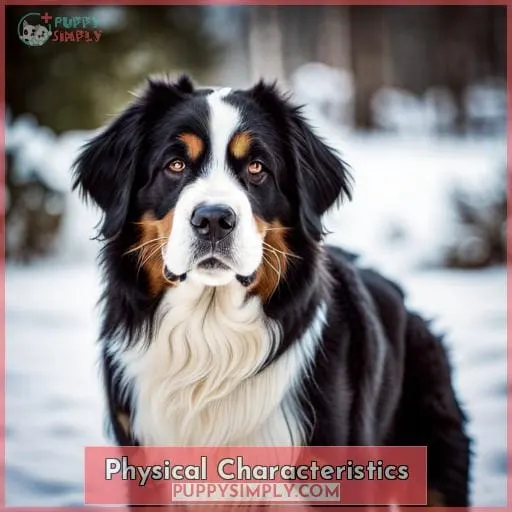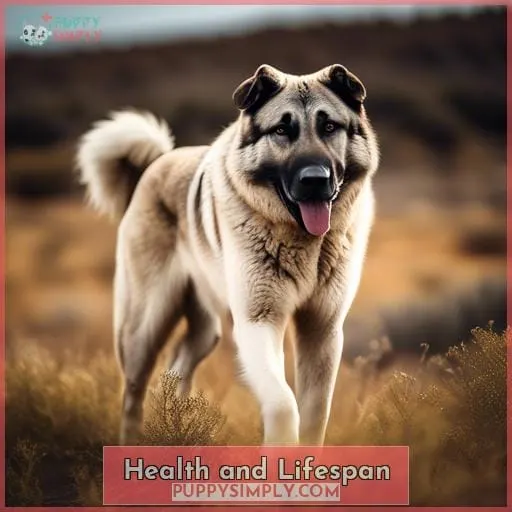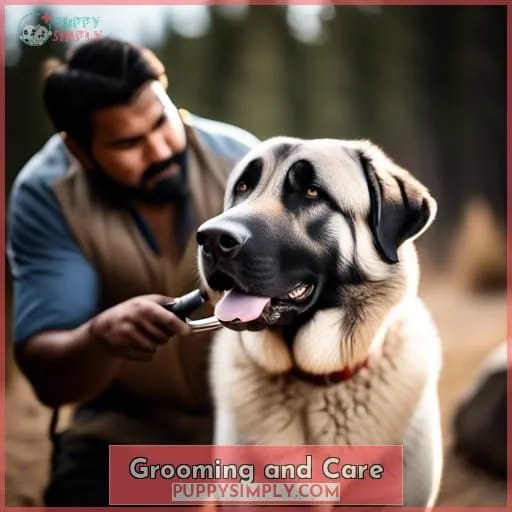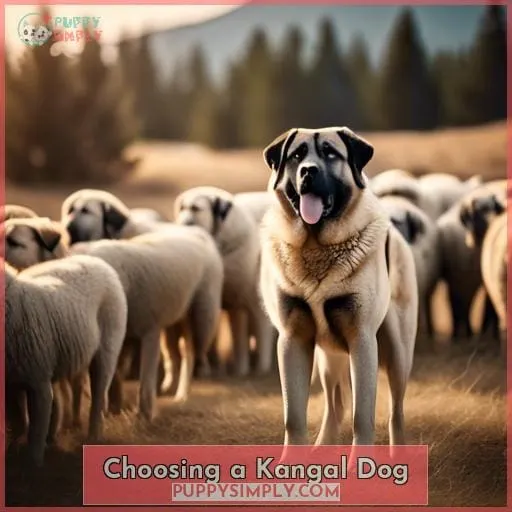This site is supported by our readers. We may earn a commission, at no cost to you, if you purchase through links.
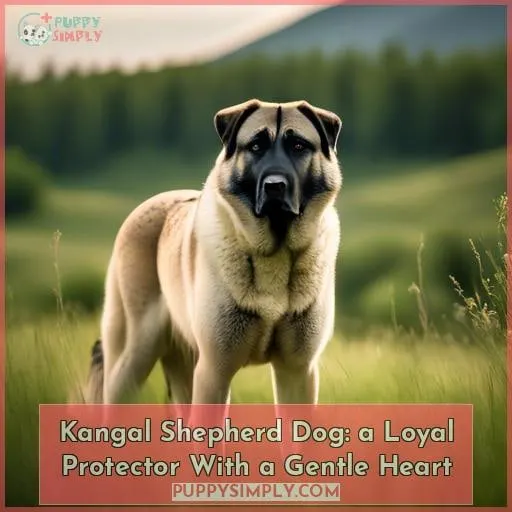 Do you crave unwavering loyalty and gentle companionship?
Do you crave unwavering loyalty and gentle companionship?
Look no further than the Kangal Shepherd Dog, a stalwart protector with a heart of gold.
This breed embodies the essence of devotion, standing guard over your family and home with unwavering vigilance.
Their protective instincts blend harmoniously with a gentle nature, making them ideal companions for those seeking both security and affection.
Discover the remarkable traits of this noble breed and embark on a journey of unwavering loyalty and companionship.
Table Of Contents
- Key Takeaways
- Kangal Dog Overview
- Temperament and Behavior
- Physical Characteristics
- Health and Lifespan
- Exercise Requirements
- Training and Socialization
- Diet and Nutrition
- Living Conditions
- Grooming and Care
- Choosing a Kangal Dog
- Frequently Asked Questions (FAQs)
- How does a Kangal Shepherd Dog typically react to strangers entering the home?
- What are some common health issues that Kangal Shepherd Dogs may experience?
- What kind of training is recommended for Kangal Shepherd Dogs to ensure good behavior and obedience?
- How much grooming is typically required for a Kangal Shepherd Dog to maintain a healthy coat and skin?
- What are the best ways to keep a Kangal Shepherd Dog entertained and mentally stimulated indoors?
- Conclusion
Key Takeaways
- The Kangal shepherd dog is a large breed, with a life expectancy of 12-15 years, known for its protective instincts and unwavering loyalty.
- The breed requires minimal grooming, but socialization is crucial to curb its prey drive and potential reactivity toward other animals.
- Common health issues include hip dysplasia, elbow dysplasia, eye problems, and bloat, with proper preventative care extending their lifespan up to 17 years.
- The Kangal shepherd dog requires ample daily exercise and mental stimulation and responds well to positive reinforcement training methods.
Kangal Dog Overview
When it comes to size, Kangals are a substantial breed, standing tall and muscular with a weight that can reach up to 140 pounds.
Their life expectancy is impressive, averaging 15 years, which is exceptional for a large breed.
As for their coats, Kangals have a thick double coat that comes in a variety of colors, including black, fawn, and gray.
Weight and Height
You’re looking at a powerful breed with a robust build when it comes to Kangal Shepherds.
These protectors come in a range of sizes, with males typically weighing between 90 and 140 pounds and standing between 28 and 32 inches at the shoulder.
Females are slightly smaller, averaging between 75 and 100 pounds and reaching heights of 24 to 28 inches.
Life Expectancy
You’ll be happy to know that Kangal Shepherds have an average life expectancy of 12 to 15 years.
This is attributed to their naturally bred genetic diversity, which minimizes hereditary health problems and inbreeding practices.
Responsible breeders often provide a certificate of lineage, ensuring healthy breeding practices and reducing the risk of genetic issues.
Kangal Shepherds are known for their exceptional health and longevity, making them a joy to have by your side for many years.
| Factor | Contribution to Longevity |
|---|---|
| Genetic Diversity | Minimizes hereditary health problems |
| Inbreeding Practices | Reduced due to responsible breeding |
| Certificate of Lineage | Ensures healthy breeding practices |
| Specialized Training | Promotes physical and mental well-being |
Coat Characteristics
Kangals have a double coat that sheds seasonally. You’ll need to brush them regularly to keep their fur healthy and mat-free. Their double coat consists of a coarser outer coat and a dense undercoat that protects them from harsh weather.
Minimal Shedding:
Despite their thick double coat, Kangals aren’t prone to excessive shedding. Regular brushing can help remove loose hair and keep your home allergy-free.
Seasonal Grooming:
During shedding seasons, increase the frequency of brushing to twice a week to manage the shedding amount and keep your dog’s coat looking its best.
Coat Colors:
Kangals typically have a fawn, gray, or black coat with distinctive white markings. Their coat colors often blend with their surroundings, providing natural camouflage.
Temperament and Behavior
When it comes to temperament, Kangal Shepherd Dogs are known for their protective instincts, gentle nature with family, and cautious approach to other animals.
This unique blend of traits makes them not only formidable guardians but also loving companions.
Protective Instincts
The Kangal Shepherd Dog’s protective instincts make it a natural guardian of your family and property.
Its unwavering loyalty and reliable guardianship stem from its inherent territorial behavior and livestock protection instincts.
With a keen eye for stranger danger and predator deterrence, the Kangal actively guards its territory and family, standing as an unwavering sentinel against any perceived threat.
Interaction With Family
When it comes to family, Kangals will shower you with unconditional love and unwavering loyalty.
As a family member, you’ll experience their unwavering loyalty, affectionate cuddles, and eagerness to please.
They’re gentle giants, especially with children, exhibiting patience and understanding.
Kangals instinctively protect their family, standing guard and intervening if they sense any danger.
They’re truly devoted companions, enriching your life with their unwavering presence and unconditional love.
Relationship With Other Animals
How does a Kangal Shepherd Dog interact with other animals, including pets and livestock?
Kangal socialization is crucial to curb their natural prey drive and ensure harmonious pet interactions.
While they bond strongly with family, proper training and behavior modification can teach them to coexist peacefully with other animals.
Kangals excel at livestock protection, prioritizing the safety of their flock over their own well-being.
Physical Characteristics
You’ll find size variations within the breed, with males typically larger than females.
Their coats are short and dense, requiring minimal grooming.
Distinctive physical traits, like their muscular build and curled tail, add to their striking appearance.
Size Variations
You’ll find size variations in Kangals, with males standing taller and weighing more than females.
Males typically weigh between 110 and 140 pounds and stand 28 to 32 inches tall at the shoulder.
Females are generally smaller, weighing 80 to 100 pounds and standing 25 to 28 inches tall.
While size differences exist, all Kangals possess the same protective instincts and gentle temperament.
Their adaptability to various living conditions makes them suitable for both spacious homes and apartments.
Coat and Grooming Needs
Moving on to coat and grooming, you’ll find that Kangals have medium-length double coats that are easy to maintain. Their coats come in a variety of colors, including fawn, black, and gray, often with white markings.
Regular brushing helps manage shedding and keeps their coats healthy.
Though generally healthy, Kangals may experience skin allergies, so monitoring their skin and coat is essential.
With proper care, Kangals are beautiful and majestic companions that bring joy to their families.
Unique Physical Traits
Upon encountering a Kangal Shepherd Dog, you’ll notice its striking physical attributes.
Its large, strong, muscular build exudes power and agility.
The broad head and powerful jaw convey determination and strength.
The tail, often carried in a distinctive curl over the back, adds to its regal appearance.
The eye color, ranging from amber to hazel, reflects intelligence and alertness.
The dewclaws, present on the hind legs, provide additional stability and traction.
Even the ear shape, often described as V-shaped and hanging, contributes to the dog’s overall majestic presence.
Health and Lifespan
You’ll discover the Kangal Shepherd Dog’s typical health problems.
How long you can expect your furry friend to be by your side.
The preventative measures you can take to keep your pup strong and happy.
Common Health Issues
Kangals are susceptible to several hereditary health issues that you should be aware of as a responsible pet owner:
- Hip dysplasia
- Elbow dysplasia
- Eye problems
Bloat, a life-threatening condition, can occur if your Kangal eats too quickly or exercises vigorously after a meal.
Regular veterinary care, early detection, and preventative measures can help keep your furry friend healthy and happy.
Prioritize your Kangal’s health by discouraging unethical breeding practices and ensuring they receive necessary health screenings.
Lifespan Expectancy
With their robust health, you’ll have many years to enjoy your Kangal’s companionship.
Their lifespan typically ranges from 12 to 15 years, with some exceptional individuals reaching up to 17 years.
This longevity is attributed to their genetic health, careful breeding practices, and overall resilience.
Providing your Kangal with proper care, including regular checkups, a balanced diet, and ample exercise, will contribute to their long and healthy life.
Preventative Care Measures
To help your Kangal live a long and healthy life, implement preventative care measures:
- Routine checkups
- Vaccinations
- Balanced diet
Stick to a vaccination schedule and deworming regimen to protect against common diseases.
Use flea and tick prevention to keep parasites at bay.
Consider spaying or neutering your dog to prevent reproductive issues and certain cancers.
Regular dental care is crucial for maintaining oral health.
By taking these steps, you’ll nurture a healthy and happy pup.
Exercise Requirements
You’ll need to provide your Kangal Shepherd Dog with ample daily exercise.
Engage them in interactive games and brisk walks to stimulate their mind and body, keeping them happy and healthy.
While exercise is crucial for their well-being, remember that mental stimulation is equally important for this intelligent breed.
Daily Exercise Needs
Given their high energy, provide your Kangal Shepherd Dog with ample daily exercise.
Aim for at least 30 minutes of vigorous aerobic activity most days. This could include brisk walks, jogging, or playing fetch.
Along with physical exercise, mental stimulation is crucial.
Engage them in interactive games, provide puzzle toys, and practice obedience training.
Suitable Activities
You’ll need to provide your Kangal Shepherd Dog with a variety of activities that challenge both its body and mind.
Engage your dog in games that stimulate its natural prey drive, such as fetch or tug-of-war.
Keep your dog mentally sharp with interactive toys and puzzle feeders.
To prevent roaming behavior, establish a routine and provide a safe, enclosed space for your dog to play.
Consider apartment suitability and provide ample exercise opportunities even in limited spaces.
Importance of Mental Stimulation
Your Kangal’s sharp mind craves mental stimulation just as much as physical exercise.
Fail to address this need, and you risk boredom, anxiety, and destructive behaviors.
Fortunately, a world of mental challenges awaits your furry companion.
Interactive Games:
Transform playtime into a mental challenge with games like hide-and-seek or fetch.
Puzzle Toys:
Treat-dispensing toys and puzzle feeders engage your Kangal’s problem-solving skills.
Interactive Toys:
Toys that move unpredictably or make sounds stimulate curiosity and provide mental exercise.
Enrichment Activities:
Create scent trails, hide treats, or play hide-and-seek to stimulate your Kangal’s senses.
Training and Socialization
Kangal Shepherd Dogs are intelligent and eager to please, making them responsive to training.
Early socialization and obedience classes can help curb their independent nature and high prey drive, setting them up for success as well-behaved companions.
Positive reinforcement and patient leadership will yield the best results in training your loyal Kangal.
Basic Training Principles
To ensure your Kangal Shepherd Dog grows into a well-behaved companion, start basic training early on.
Consistent, positive reinforcement methods work best with this breed.
Address stubbornness with patience and understanding.
Socialization is crucial for Kangals. Introduce them to various people, animals, and situations from puppyhood.
Control their high prey drive with obedience training and mental stimulation activities.
Socialization Importance
Socialization is equally important as training, so start introducing your Kangal to various people, animals, and environments from an early age.
Your Kangal’s breed history as a livestock guardian may make it wary of strangers and other animals.
Obedience training classes can teach your Kangal appropriate behaviors around others and help you build a strong bond.
Addressing High Prey Drive
How can you effectively address the high prey drive of a Kangal Shepherd Dog through training and socialization?
Engage in recall training to instill obedience, reinforcing their return to you despite distractions.
Implement socialization techniques to familiarize your Kangal with other animals, fostering understanding and acceptance.
Practice off-leash control in secure environments, gradually increasing freedom as they demonstrate reliable behavior.
Diet and Nutrition
You’ll want your Kangal Shepherd to live a long and healthy life, and a key component of that is their diet.
Focus on high-quality dog food that provides the right balance of protein, fat, and carbohydrates for their age and activity level.
Avoid overfeeding, as Kangals are prone to obesity.
Ideal Diet Composition
When devising a diet plan for your Kangal Shepherd Dog, it’s crucial to consider:
- Their size
- Energy level
- Any specific health conditions they may have
A balanced diet should include:
- High-quality protein sources
- Healthy fats
- Complex carbohydrates
- Vitamins
- Minerals
Consult your veterinarian to determine the ideal macronutrient ratios for your dog.
Additionally, monitor their food intake to prevent:
- Obesity
- Associated health issues
Be mindful of:
- Food allergies
- Intolerances
Introduce new foods gradually to avoid:
- Digestive upset
Managing Food Intake
To maintain your Kangal’s svelte figure and prevent obesity’s unwelcome embrace, you must strictly monitor their food intake, adjusting portions to match their activity level and metabolic needs.
Establish a consistent feeding schedule, dividing daily rations into two or three smaller meals to prevent gastric distress.
Prioritize a balanced diet rich in high-quality protein, healthy fats, and essential nutrients, avoiding fillers that offer little nutritional value.
Supplements and Health
With your veterinarian’s guidance, consider adding supplements to your Kangal’s diet to promote joint health and overall well-being.
Supplements can bolster their immune system, improve skin and coat health, and support healthy digestion.
However, not all supplements are created equal. Research and choose high-quality products that align with your Kangal’s specific nutritional needs.
Living Conditions
When considering a Kangal Shepherd Dog, you’ll want:
- Ample space for the dog to roam, play, and feel safe.
- Temperate climates suit them best, though they can adapt to various weather conditions with appropriate shelter.
- Their protective instincts make them ideal for guarding your home and family.
Suitability for Apartment Living
Considering the Kangal Shepherd Dog’s size, energy level, and protective nature, assessing their suitability for apartment living is important.
Quiet Companionship:
- Kangals can be quiet and relaxed indoors, making them suitable for apartment living if they receive adequate exercise.
Neighbor Considerations:
- Be mindful of neighbors’ comfort by choosing a low-energy Kangal and ensuring minimal noise disturbance.
Urban Adaptation:
- Kangals can adapt to apartment living with proper training, socialization, and regular exercise.
Space and Environment Needs
You’ll need a spacious yard and a well-fenced property for your Kangal to roam and protect.
Their outdoor space should provide ample room for exercise, play, and mental stimulation to prevent boredom and behavioral challenges.
Kangals thrive in environments that offer opportunities for exploration, environmental enrichment, and interaction with their human family.
Ensure your yard is secure to contain this powerful breed and prevent them from roaming freely, which could lead to territorial disputes or confrontations with other animals.
Adapting to Weather Conditions
Selecting a location protected from extreme temperatures will help your Kangal adapt to the weather conditions.
Their thick coat provides insulation against cold climates, but they can struggle in extreme heat.
Providing shade and access to cool water during hot summer days is crucial.
Conversely, in cold climates, a warm, draft-free shelter is essential.
Kangals’ resilience to various climates showcases their adaptability, making them suitable companions in diverse weather conditions.
Grooming and Care
To keep your gentle giant at their best, you’ll want to establish a grooming routine that includes:
- Regular brushing to manage shedding.
- Nail trims to maintain healthy paws.
- Dental care to ensure a sparkling smile.
Regular Grooming Tasks
With their dense double coat, Kangal Shepherd Dogs require regular brushing to maintain a healthy, clean appearance.
- Employ proper brushing techniques to remove dead hair and prevent matting.
- Utilize deshedding tools during shedding season to manage loose fur.
Maintain dental hygiene by brushing teeth regularly to prevent dental issues.
Clean ears gently to prevent infections and buildup of debris.
Inspect skin for any abnormalities and address skin conditions promptly.
Managing Shedding
Kangal Shepherds’ thick coats require regular brushing to manage shedding and keep their coats healthy.
Embrace the bonding experience as you groom your loyal companion, gently removing loose fur and preventing mats.
Utilize grooming hacks like slicker brushes and undercoat rakes to effortlessly remove dead hair, revealing their radiant, lustrous coat.
With consistent fur maintenance, you’ll not only keep your home fur-free but also ensure your Kangal Shepherd feels comfortable and looks their majestic best.
Nail and Dental Care
Regular nail trimming and dental hygiene are essential to maintain your Kangal’s overall health and well-being.
Keep their claws clipped to prevent painful overgrowth and potential injuries.
Brush your Kangal’s teeth regularly using a toothbrush and dog-friendly toothpaste to maintain optimal oral hygiene and prevent dental issues.
Incorporate dental chews into their routine for added oral health benefits.
Choosing a Kangal Dog
Choosing a Kangal dog is a big decision.
Think about its size, independence, and aversion to smaller animals.
Before you bring one home, you must be prepared to handle its massive strength, stubbornness, and protective instincts.
Positive Traits of Kangals
Your Kangal’s positive traits include:
- Cuteness
- Temperament
- Independence
- Impressive lifespan
Revel in their goofy charm, watching them mature slowly, retaining their puppy-like charm for up to three years.
Their protective loyalty will make you feel safe and secure, while their non-reactive demeanor towards smaller dogs showcases their gentle nature.
Enjoy their autonomous decision-making, as they thrive on independence and form strong bonds with their families.
Reasons Not to Get a Kangal
Despite their positive traits, there are some reasons why a Kangal might not be the right fit for you.
Their size and strength can be challenging to manage, and their independence and stubbornness can make training difficult. Additionally, their aversion to smaller animals and roaming behavior can be problematic.
If you’re considering getting a Kangal, carefully weigh the pros and cons to ensure they’re a good fit for your lifestyle and experience level.
| Challenges | Ownership | Responsibility | Alternatives | Considerations |
|---|---|---|---|---|
| Size and strength | Evaluate your physical ability to manage a large, powerful dog. | Ensure you have the time and resources to provide adequate exercise and training. | Consider smaller, more manageable breeds if strength is a concern. | Assess your lifestyle and living space to ensure it’s suitable for a Kangal. |
| Independence and stubbornness | Be prepared for a dog with a mind of its own. | Establish clear boundaries and rules, and be consistent with training. | Look for breeds known for their obedience and eagerness to please if you prefer a more compliant dog. | Evaluate your patience and willingness to invest time in training. |
| Aversion to smaller animals | Be aware of their natural instinct to chase and kill small creatures. | Take precautions to keep your Kangal away from cats, rabbits, and other small pets. | Choose a breed with a lower prey drive if you have other small animals. | Assess your ability to control your Kangal’s behavior around smaller animals. |
Adaptability and All-around Friendliness
Given their adaptability and all-around friendliness, Kangal Shepherd Dogs make exceptional companions for families seeking loyal and affectionate canine partners.
Seamlessly Adapting Behavior:
Kangals adapt to your lifestyle, becoming placid indoors and vigilant outdoors.
Social Integration:
They excel at neighbor relations, welcoming visitors and workmen with a gracious demeanor.
Compatibility Assessment:
Evaluate your living space, activity level, and family dynamics to ensure a harmonious coexistence.
Kangals offer a unique blend of loyalty, protectiveness, and friendliness, making them ideal urban companions for families seeking a devoted and loving canine friend.
Frequently Asked Questions (FAQs)
How does a Kangal Shepherd Dog typically react to strangers entering the home?
When strangers enter your home, your Kangal Shepherd Dog remains calm and composed, assessing the situation with its keen senses.
It may bark to alert you of their presence, but it won’t exhibit aggressive behavior unless it perceives a threat.
What are some common health issues that Kangal Shepherd Dogs may experience?
Kangal Shepherd Dogs may face health challenges like:
- Hip dysplasia
- Elbow dysplasia
- Eye problems
Regular checkups and a healthy lifestyle can help ensure your loyal companion stays strong and vibrant.
What kind of training is recommended for Kangal Shepherd Dogs to ensure good behavior and obedience?
Kangal Shepherd Dogs respond well to positive reinforcement and gentle leadership.
With patience and consistency, you can teach your loyal companion basic commands and tricks, fostering a strong bond and ensuring obedience.
How much grooming is typically required for a Kangal Shepherd Dog to maintain a healthy coat and skin?
Regular grooming is vital for your Kangal Shepherd Dog’s health and well-being.
Brush their coat several times a week to remove dirt, debris, and loose hair.
Bathe them as needed, typically once or twice a month, using a gentle dog shampoo.
What are the best ways to keep a Kangal Shepherd Dog entertained and mentally stimulated indoors?
Engage your Kangal Shepherd’s sharp mind with indoor games that mimic their natural instincts.
Hide treats, play tug-of-war, or set up obstacle courses to stimulate their curiosity and provide mental challenges.
Conclusion
Like an impenetrable fortress, the Kangal Shepherd Dog stands unwavering in its devotion,
guarding your world with a gentle touch.
Their unwavering loyalty and protective nature make them more than just pets;
they’re family, forever by your side, ensuring your safety and showering you with unwavering affection.
If you seek a companion who embodies both steadfast protection and unwavering love,
look no further than the Kangal Shepherd Dog, a breed that will forever hold your heart captive.

